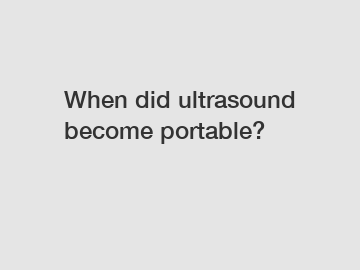When did ultrasound become portable?
When did ultrasound become portable?
Ultrasound technology has revolutionized the field of medical imaging, allowing healthcare professionals to visualize internal structures and diagnose a wide range of conditions. The ability to carry ultrasound devices and perform scans in various settings has transformed the way healthcare is delivered. But when exactly did ultrasound become portable? Let's delve into the history and evolution of portable ultrasound, exploring its impact on healthcare and the advantages it brings.
1. The Origins of Ultrasound:

Ultrasound, as a medical diagnostic tool, has roots dating back to the early 20th century. Initially developed for submarine detection during World War I, ultrasound technology evolved over time, finding its way into medical practice by the 1950s. However, early ultrasound devices were far from portable. They were large, heavy machines that required specialized facilities and trained personnel to operate.
2. Advancements in Miniaturization:
The quest for portability led to significant advancements in miniaturization of ultrasound equipment. As computing technology advanced, ultrasound machines became more compact and user-friendly. By the 1980s, portable ultrasound devices were being introduced, although they were still bulky compared to today's standards.
3. Emergence of Handheld Ultrasound:
The real breakthrough in portable ultrasound came with the emergence of handheld devices. These compact, pocket-sized scanners began gaining popularity in the early 2000s. Their small size and ease of use democratized access to ultrasound technology, enabling quick assessments and interventions at the point of care. Physicians in remote settings, emergency rooms, and even ambulances could now perform ultrasound scans on the spot.
4. Technological Innovations:
5. Impact on Point-of-Care Diagnostics:
The portability of ultrasound has transformed point-of-care diagnostics. Physicians can now use ultrasound to evaluate patients in real-time, reducing the need for invasive procedures and potentially avoiding unnecessary delays in diagnosis. Portable ultrasound devices have become valuable tools in emergency medicine, critical care units, and even for home health visits.
6. Expanding Applications:
As ultrasound became portable, its applications expanded beyond traditional uses. Alongside obstetrics and cardiology, portable ultrasound devices now cater to specialties such as musculoskeletal, vascular, and even veterinary practices. The versatility and ease of use of these devices have broadened their reach, making ultrasound an indispensable tool across medical disciplines.
7. Accessible Healthcare in Remote Areas:
Portable ultrasound has opened doors for accessible healthcare in remote and underserved areas. By eliminating the need for patients to travel long distances to receive specialized care, portable ultrasound devices enhance healthcare accessibility. This is particularly vital in developing countries and regions with limited access to medical facilities.
8. Training and Education:
The portability of ultrasound has not only changed patient care but also revolutionized medical education. Healthcare professionals can now incorporate ultrasound training into their curriculum more easily. Portable devices allow for hands-on learning, enhancing practical skills and improving diagnostic capabilities. This empowers healthcare providers to deliver more accurate and timely diagnoses, ultimately leading to improved patient outcomes.
In conclusion, ultrasound technology has come a long way since its inception. The journey from large, immobile machines to compact handheld devices has transformed medical practice. Portable ultrasound has revolutionized point-of-care diagnostics, expanded medical applications, and increased accessibility to healthcare. With ongoing technological advancements, it's exciting to imagine where portable ultrasound will take us in the future. As the world becomes more interconnected and healthcare needs continue to evolve, portable ultrasound is set to play an increasingly significant role in delivering efficient, accurate, and accessible care.
For more hand held ultrasound, lease ultrasound machine, handheld sonogram for healthcare professionalsinformation, please contact us. We will provide professional answers.

Comments
0